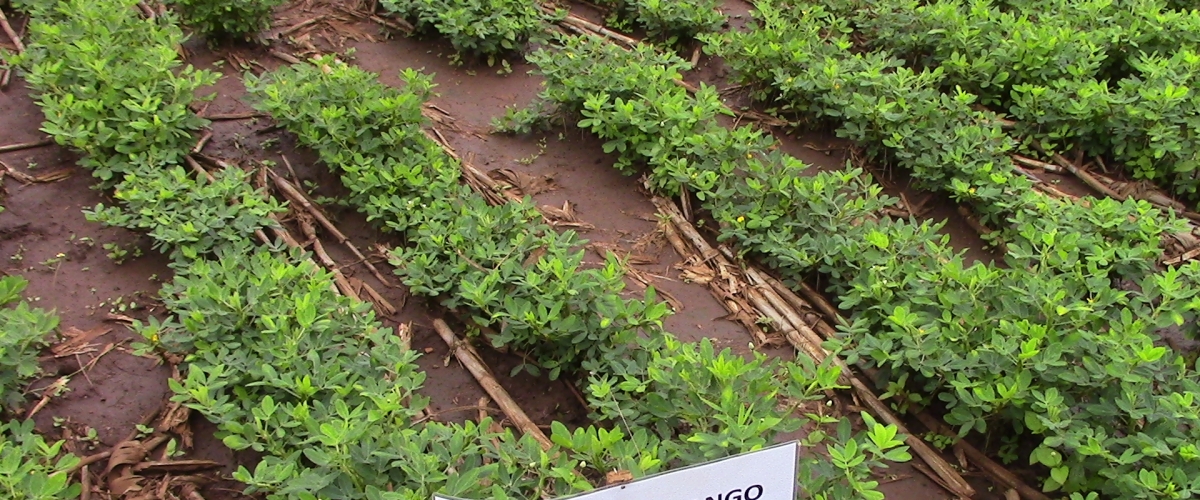
By Gloria Siwisha
Groundnuts are one of the most important crops grown in the Eastern province of Zambia. According to Chapoto and Zulu-Mbata (2015), nearly two-thirds of households in the region produce groundnuts as both a food crop and source of income. In the last two decades, however, smallholder farmers in the country have experienced a decline in groundnuts production and productivity. During the 2011/2012 agricultural season, for instance, the total quantity of shelled groundnuts produced by smallholders significantly reduced to 113,000 metric tonnes from about 160,000 metric tonnes recorded in the 2009/2010 agricultural season (IAPRI, 2013). Groundnut yields also remained low, ranging between 0.5 and 0.7 metric tonnes per hectare, compared to the global averages of around 1.7 metric tonnes.
Experts in the region attributed the low productivity levels to inappropriate farming practices; seed recycling, pests and diseases, as well as climate variability. In an effort to find solutions to these problems, the Ministry of Agriculture through the Zambia Agriculture Research Institute (ZARI), executed the six-year World Bank-funded Agriculture Productivity Programme for Southern Africa (APPSA). Eastern province, in particular, implemented two APPSA sub-projects. The first focused on breeding high yielding, multiple disease resistant groundnut varieties suitable for Zambia, Malawi and Mozambique, while the second looked at improving productivity in low soil fertility and drought-prone areas.
APPSA is a Centre for Coordination of Agricultural Research and Development for Southern Africa (CCARDESA) programme. It works with country-specific and regional research stations in order to increase the availability of improved agricultural technologies in participating countries in the Southern African Development Community (SADC) region. Phase one of the project was implemented in Zambia, Malawi and Mozambique from 2013 to 2019. In the six years of project implementation in the three countries, it benefited over 750,000 households. The project has now been extended to Lesotho and Angola where it is expected to be implemented until 2025.
According to Msekera research station programmes officer Kennedy Kanenga, who was also Principal Investigator on two APPSA sub-projects, Zambia was a regional centre of leadership for food legumes, while Malawi and Mozambique were regional centres of leadership for maize and rice respectively. He said the goal of APPSA in Zambia was to improve food, nutrition security, and incomes of smallholder farmers through increased crop productivity in selected areas. “In order to realise the goals of the two APPSA sub-projects that were implemented in Eastern province, Msekera research station, working with the International Crops Research Institute for the Semi-Arid Tropics (ICRISAT), conducted basic seed multiplication programmes with both individual farmers and out-grower schemes,” he said.
According to Mr Kanenga, the APPSA project, although having closed-out in Zambia, is still hailed in the region for increasing access to improved groundnut seed, grooming farmers that can produce quality seed, and also preparing the ground for other investments. “We shall continue to engage organised farmer groups in seed multiplication programmes through our seed unit in order to sustain the production of quality seed,” Mr Kanenga said. Beneficiary farmers are also happy with the knowledge and skills gained through the seed multiplication programmes.
Joseph Nyangu, a lead farmer of Chinjala resettlement area in Chipata district of Eastern Province, is one of the successful seed growers groomed by the APPSA project. He was first engaged as a basic groundnut seed grower by Msekera research station during the 2015/2016 agriculture season. After having produced basic groundnut seed for some time, Mr Nyangu, as a lead farmer, has now become an employer to the fellow farmers in his community. Every season, he sub-contracts smallholder farmers to help produce basic groundnut seed. The farmers he employs are first subjected to training under Msekera research station on best management practices so that only quality seed is produced.
“During the 2017/2018 agriculture season, I acquired 1200 Kilogrammes of basic seed from the research station to plant on 15 hectares of land. Because of the huge volumes of seed involved, I sub-contracted 30 farmers who helped me multiply part of that seed,” he said. According to Mr Nyangu, the APPSA project has enabled him and his fellow farmers to realise significant benefits. “Once the farmers I sub-contract have re-paid the groundnut seed that they get from me, I go a step further to buy back from them the excess seed at a good price. That way, I am able to give back to Msekera research station the right quantities of seed, while at the same time, empowering my follower farmers with knowledge and also providing them with a ready market,” he said.
The regional approach of breeding quality groundnut seed, increasing accessibility, and linking farmers to markets is certainly bearing fruit. Such initiatives should be replicated to other crop commodities in order to avert the problem of low agriculture production and productivity in the SADC region.
The author is a journalist specialised in Agriculture and Climate Change. She currently works for the National Agricultural Information Services (NAIS) in Eastern Province, Zambia.






